Biographical Log of Michael Furstner - Page 307
12 | 13 ||
2014 :
Jan |
Feb |
Mar |
Apr |
May |
Jun |
Jul |
Aug |
Sep |
Oct |
Nov |
Dec || Page :
Previous |
Next
Martinshof Story -
Happiness -
Awareness -
Black Forest walks -
Camino -
Dolmen Tour -
Travel
Most Recent -
Next -
Previous -
Page 1 -
Photos -
Maps & Articles -
MP3s -
Jazclass
Tuesday 16 & Wednesday 17 September, 2014
(diary)
 I am having some very nice peaceful days, often happy just to
sit on my balcony and absorb and feel part of this typical
Black Forest rural environment which of course is so totally
different from our tropical environment back in Darwin.
I am having some very nice peaceful days, often happy just to
sit on my balcony and absorb and feel part of this typical
Black Forest rural environment which of course is so totally
different from our tropical environment back in Darwin.
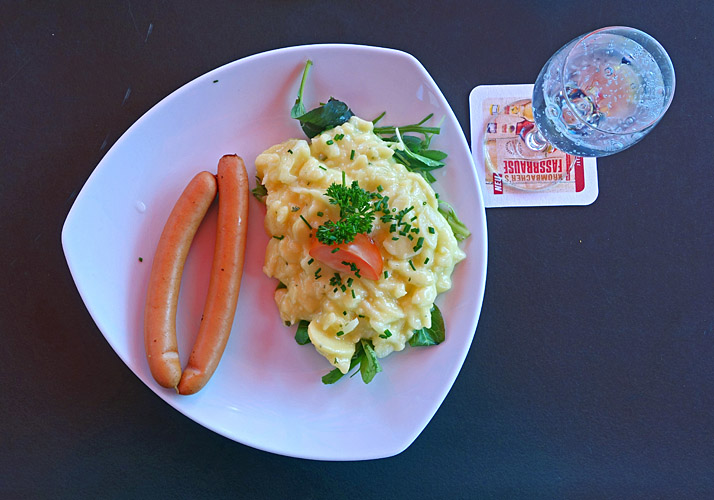 All the same I also did a good walk this Wednesday, a 6km hike
from Bärental to Titisee,
one of my favourites. The first 4km are through a densely wooded forest of enormous
pine trees, gradually descending from 967 meters above sea
level at the Bärental railway
station to around 800 meters at the Titisee lake. The final 2km are
right along the shores of the lake.
All the same I also did a good walk this Wednesday, a 6km hike
from Bärental to Titisee,
one of my favourites. The first 4km are through a densely wooded forest of enormous
pine trees, gradually descending from 967 meters above sea
level at the Bärental railway
station to around 800 meters at the Titisee lake. The final 2km are
right along the shores of the lake.
The village of Titisee is a very popular tourist place,
always with lots of tourists milling around. I found a bistro
where they had one of Germany's iconic lunch dishes on the menu
(surprisingly most restaurants here did not) : Wienerle mit
Kartoffelsalat.
I got into a lively conversation with the couple (Bruno and his
wife) on the table next to mine (I keep practicing my German at
every opportunity) who tried to talk me into ending my meal
(Bruno had the Wienerle too) with a local (?) schnapps invention
: Himbeertraum (Raspberry
dream).
At first I firmly resisted, but when one glass of
it was served to Bruno's wife I of course had to try one too.
Never seen anything like it. The bouquet has a very strong
raspberry flavour, but the drink itself is not sweet at all and
quite potent with its 40+% alcohol content. I loved it and it
will certainly be an incentive to come back to this place again
!
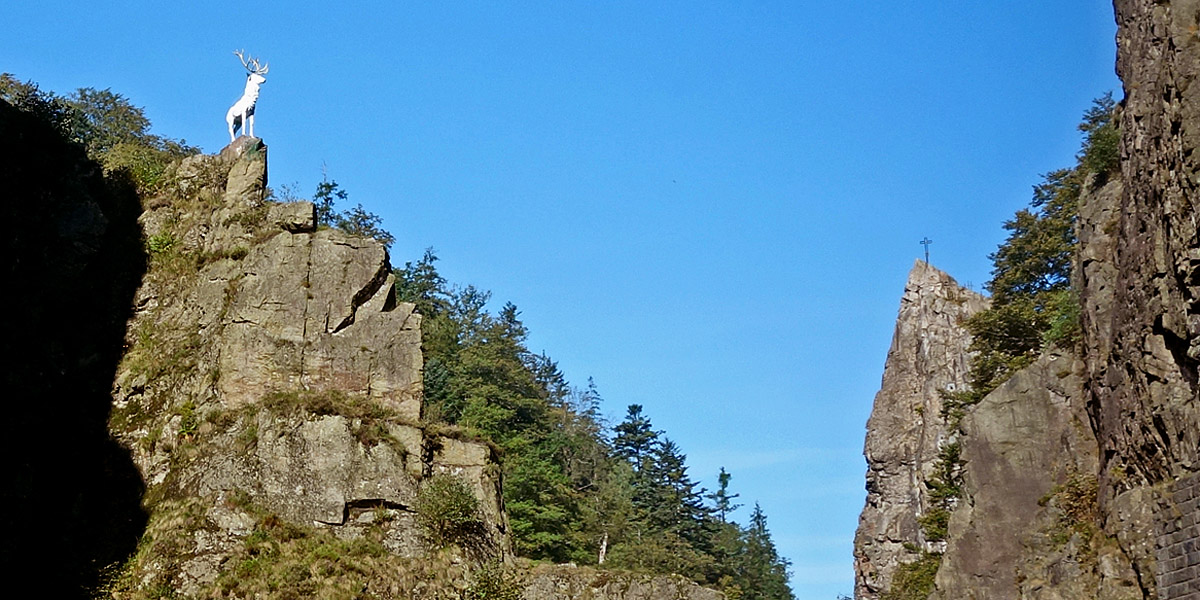 The best part of this all round great day was my train trip.
The best part of this all round great day was my train trip.
From Freiburg to
Seebrug runs the iconic Höllentalbahn railway
line. It meanders through some stunning countryside including
the Höllental (Hell valley gorge), the Titisee and the Schluchsee.
Two years ago the
Höllental gorge was being cleaned up, removing some
dangerous rocks, securing others and removing the Deer sculpture on top of it for
cleaning and restoration. But now the deer is back, cleaned and
firmly bolted onto its spectacular rock face.
Legend has
it that a deer, chased by hunters, once jumped right across the
gorge (then only 7 meters wide) from one side to the other.
Riding in the train one has only a few precious seconds
to see and photograph the deer, so I was mightily pleased to
get this picture.
Most Recent -
Next -
Previous -
Page 1 -
Photos -
Maps & Articles -
MP3s -
Jazclass
Thursday 18 - Monday 22 September, 2014
(diary)
 Shown above a 180° view of the place where I am staying. The main
house of the Steingrubenhof is on the left with the holiday
apartments in the building in the center. My apartment,
called Feldbergblick (as it looks out onto that mountain) has the
balcony in front from which I catch the sun (whenever there is
some) throughout the day.
Shown above a 180° view of the place where I am staying. The main
house of the Steingrubenhof is on the left with the holiday
apartments in the building in the center. My apartment,
called Feldbergblick (as it looks out onto that mountain) has the
balcony in front from which I catch the sun (whenever there is
some) throughout the day.
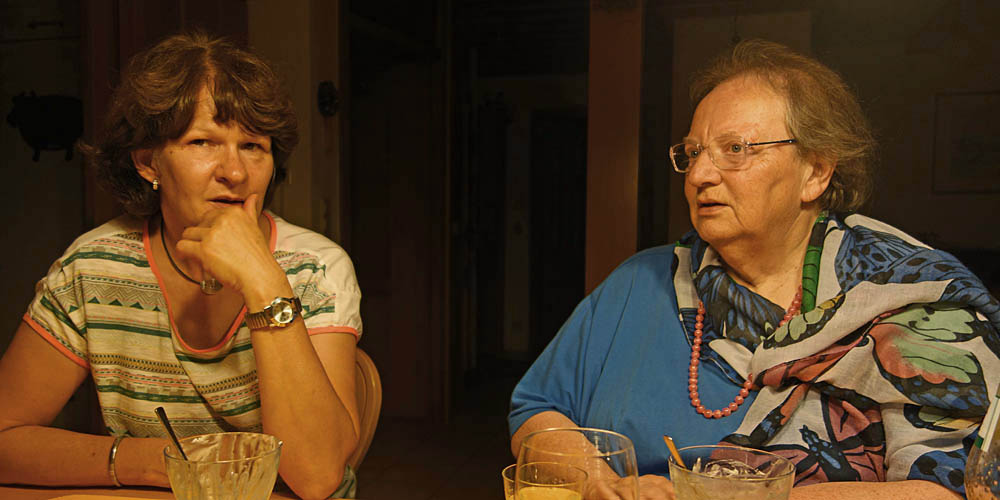 Thursday evening Wivica and I were invited for dinner by my
landlords, Georg and
Lydia (photo taken in 2012). It was an absolutely wonderful
meal.
Thursday evening Wivica and I were invited for dinner by my
landlords, Georg and
Lydia (photo taken in 2012). It was an absolutely wonderful
meal.
Lydia's entree, a
sushi style roll of salmon, soft white cheese and finely
chopped spinach (mixed with egg white to keep it togeher) was especially
eye-catching and truly delicious. The Bauernbratwurst mit Brägle
(pan-fried potatoes) were also like you only can eat them in
Germany.
Georg sold his milk cows recently and it has done him the world
of good. He looks 10 years younger and is far more happy and
outgoing than I knew him 2 years ago. He used to get up every
morning at 4.30am, seven days a week, without interruption for 50
years, to milk his cows.
That is all over
now. They still have some other animals and fields to look
after, but their lifestyle is now far more pleasant and relaxed.
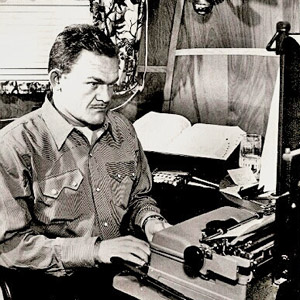 Thanks goodness for e-books. These days, when bookstores
are full of one-day wonders (here today, gone tomorrow),
quality literature (apart from the usual Austen, Dickens,
Hardy, Tolstoy novels) is nowhere to be seen.
Thanks goodness for e-books. These days, when bookstores
are full of one-day wonders (here today, gone tomorrow),
quality literature (apart from the usual Austen, Dickens,
Hardy, Tolstoy novels) is nowhere to be seen.
So I am
steadily building my e-book library which gives me a wonderful
selection to read from.
One of the classics I read way
back in the 60s or 70s was James Jones' From
Here to Eternity. I enjoyed it, but doubt whether I
back then really perceived the depth and power of this
supreme novel.
I am in the middle of reading it again right now and am
gradually being swayed to the realisation that (in time) James Jones may be regarded as
one of the two most powerful literary writers of the
20th century.
The other writer of course being Ernest
Hemingway.
In my view Hemingway and Jones represent the two extremes of
modern literature writing :
Ernest Hemingway, the "minimalist", with his
stark, super economic style, leaving everything out that is not
absolutely necessary, yet saying everything there is to say.
James Jones, the "maximalist", with a most
lyrical style with frequent emotional "tsunamis" in
which he puts everything in he possibly can and more : a
sustained torrent of creative insights, reflections and
feelings, no other writer I know of has ever come close
to.
|
Apart from both being American, these two writers have one
life-changing experience in common : the horrors of war.
Hemingway as an ambulance driver in Italy during WW1 (A Farewell
to Arms), Jones as a soldier fighting the Japanese on islands
in the Western Pacific (Guadalcanal !) during WW2.
Perhaps only after such continued close encounters with the
most gruesome deaths is one able to fully appreciate and
unambiguously write about life !
Most Recent -
Next -
Previous -
Page 1 -
Photos -
Maps & Articles -
MP3s -
Jazclass
Tuesday 23 - Saturday 27 September, 2014
(diary)
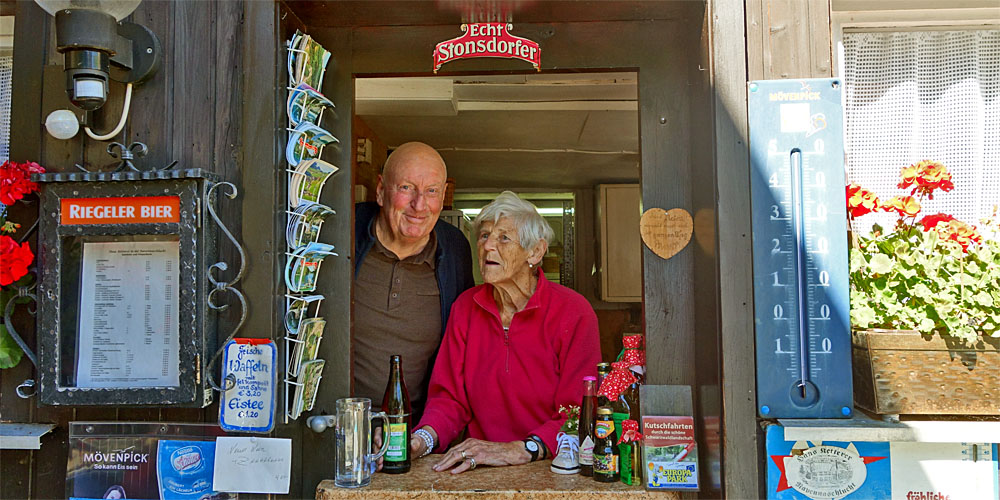 Although I always try to look at and visit some new places
(like the next 18 days for example), my stays in Europe
are never really tourist trips. My main aim is to re-engage aspects of my identity that have little or no
chance to come to the fore while living in
Australia.
Although I always try to look at and visit some new places
(like the next 18 days for example), my stays in Europe
are never really tourist trips. My main aim is to re-engage aspects of my identity that have little or no
chance to come to the fore while living in
Australia.
Firstly this consists of re-connecting with my sister
Wivica, my school and university friends in the
Netherlands and also with the long-time employees from our
former family business Martinshof.
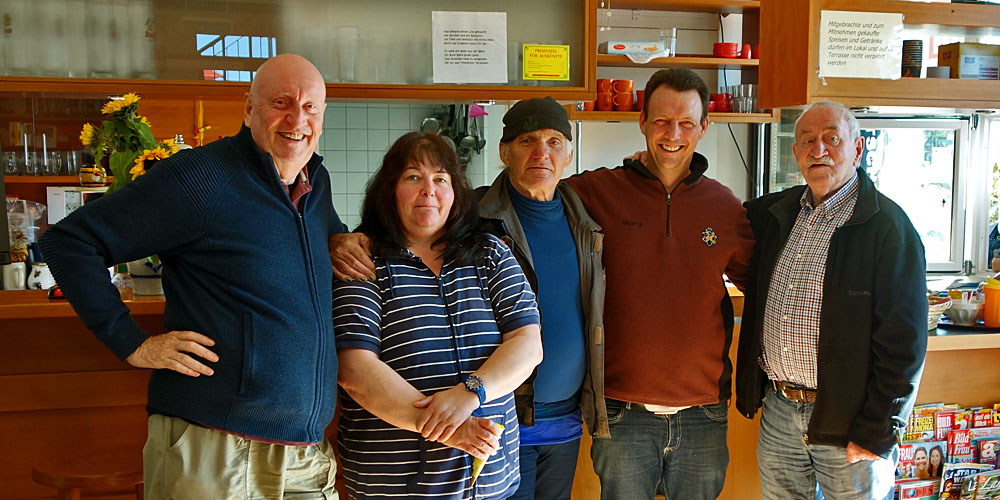 Secondly it gives me a chance to speak Dutch and
German again, which is a great joy to me, and I take every
opportunity I can to engage strangers in conversation, in
Pubs, the train, etc.
Secondly it gives me a chance to speak Dutch and
German again, which is a great joy to me, and I take every
opportunity I can to engage strangers in conversation, in
Pubs, the train, etc.
Yesterday for example I had
missed a train in Schluchsee (having completed
walk 3a). I had to wait for an hour for
the next train to arrive, but fired up by a couple of
glasses of wine I struck up a great conversation with
several people in the Bistro there.
 Thirdly it is of course the food, typical of the
countries' culture. Dishes you rarely come across (if at
all) in Australia.
Thirdly it is of course the food, typical of the
countries' culture. Dishes you rarely come across (if at
all) in Australia.
Dutch : Bitterballen and also
Bruine bonen met Spek (brown beans with bacon and
onions), Loempias (huge spring rolls) and Bami
Goreng the Dutch/Indonesian way, with flat noodles and
many extras.
German :Königsberger
Klopse, Mainzer
Handkäse mit Musik, Pfifferlinge,
etc.
French : Pate de Fois
Gras, Grenouilles.
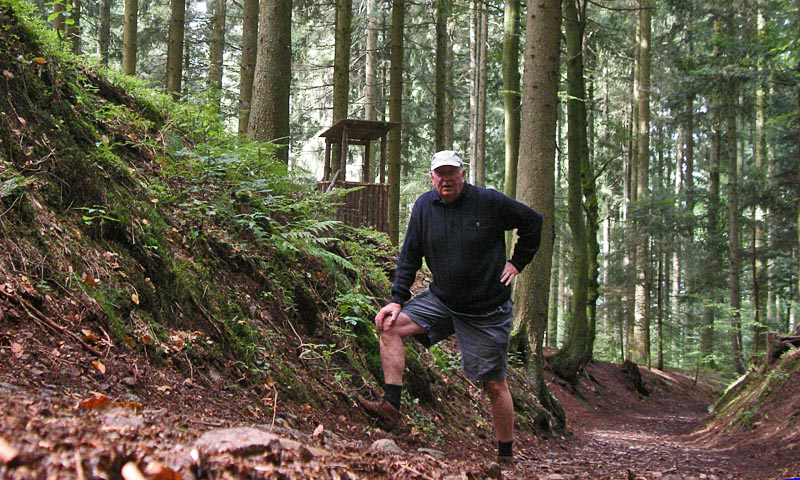
But fourthly I have a need for something of a much deeper origin, tucked away in an
obscure area of my DNA, passed on by ancestors for five
centuries or more.
My surname gives a clue to what I am
talking about : Furstner is derived from
Förster, meaning "forester" in English.
My parental ancestors from the early 1600s came from
Austria and Southern Germany with (as our name reveals) a
close connection to and love for the forests.
This
is why I always take long walks through the forests here. I
enjoy the forests in the Netherlands and around Altenahr
which I recently visited again. But it is on the narrow
walking trails through the Black Forest where I feel an
affinity like nowhere else.
I do not belong
there any longer myself (I belong in Australia). But I do
perceive the strong sense of belonging
my ancient ancestors must have felt for this
wonderful environment, with its huge trees, the mosses,
toadstools, berries, ferns, the bubbling clear springs
and the mysterious darkness that prevails.
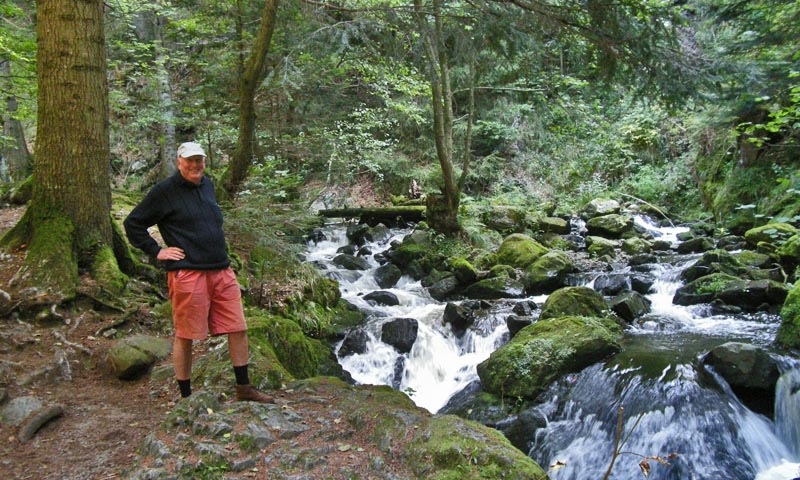 But the love for these forests is not the only
characteristic my ancient ancestors passed on to me and
my family. It is a sense of restlessness, of
searching for a new place to live, for a "new identity" which has been a constant feature throughout our
parental line.
But the love for these forests is not the only
characteristic my ancient ancestors passed on to me and
my family. It is a sense of restlessness, of
searching for a new place to live, for a "new identity" which has been a constant feature throughout our
parental line.
My father traced back from the early
1600s a sustained urgency of our ancestors to move to a new place to live, not two
generations ever lived at the same place.
They traveled
from Austria, west through Southern Germany until they
reachd the Rhine.
Then every successive generation moved
northward along the Rhine until they finally arrived in
the Netherlands in the 18th century, then a country of great
enlightenment.
After restlessly shifting for several generations
to different places in Holland (my father purchasing land within a forest and building our home Martinshof there), it was I (followed
shortly after by my
brother Claus) who made the jump to Australia, the
ultimate country of freedom on this planet.
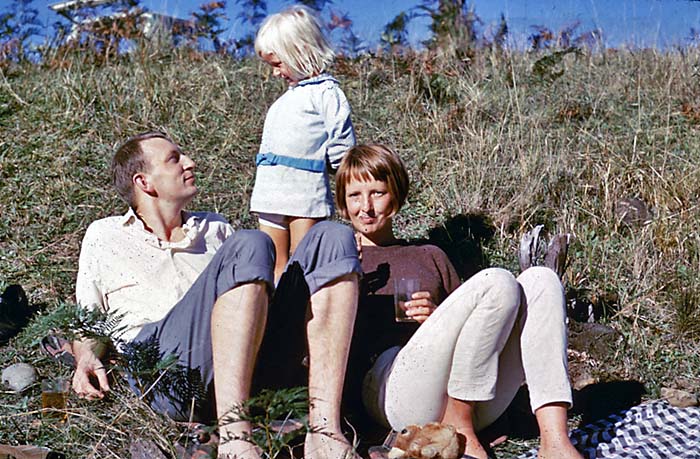 It was only on my previous visit to Europe two
years ago in 2012 that I suddenly woke up to this overwhelming truth
: I had completed the journey which my early ancestors had
started at least 500 years ago (or perhaps much
earlier).
It was only on my previous visit to Europe two
years ago in 2012 that I suddenly woke up to this overwhelming truth
: I had completed the journey which my early ancestors had
started at least 500 years ago (or perhaps much
earlier).
Tears were streaming from my eyes and I had an
enormous sense of satisfaction of having achieved our mutual goal. Because of this I now feel a much stronger connection and bond with all those gnerations who have preceded me.
Interestingly, my sister Wivica (perhaps because of her strong spirituality)
was attracted by the original environment of our early
ancestors, and has lived now in the Black
Forest for many years.
Therefore between the two of us we mark the beginning as
well as the end of our ancestral journey on this
planet : a meaningful conclusion.
Most Recent -
Next -
Previous -
Page 1 -
Photos -
Maps & Articles -
MP3s -
Jazclass
Sunday 28 - Tuesday 30 September, 2014
(diary)
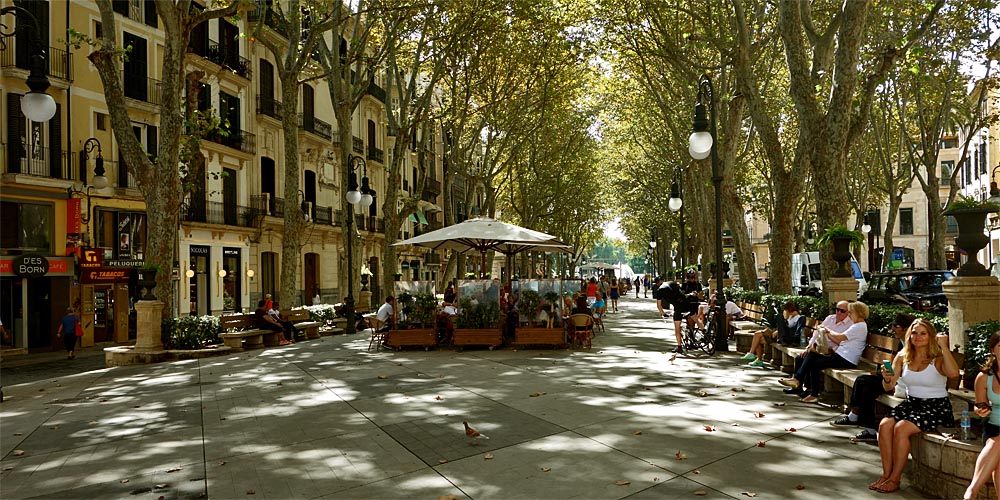 Flying within Europe are a breeze. I was hardly through
my second G&T (with Bombay Saphire of course) when we
landed in a rainy and miserable Palma de Mallorca. The city has a rather disorganised appearance, bu the old inner part with may ancient buildings does have its charm.
Flying within Europe are a breeze. I was hardly through
my second G&T (with Bombay Saphire of course) when we
landed in a rainy and miserable Palma de Mallorca. The city has a rather disorganised appearance, bu the old inner part with may ancient buildings does have its charm.
Luckily I guessed the bus right first time and arrived dry at my
hotel, Hotel
Almudaina. A really nice room with enormous modern
paintings and all the modcons.
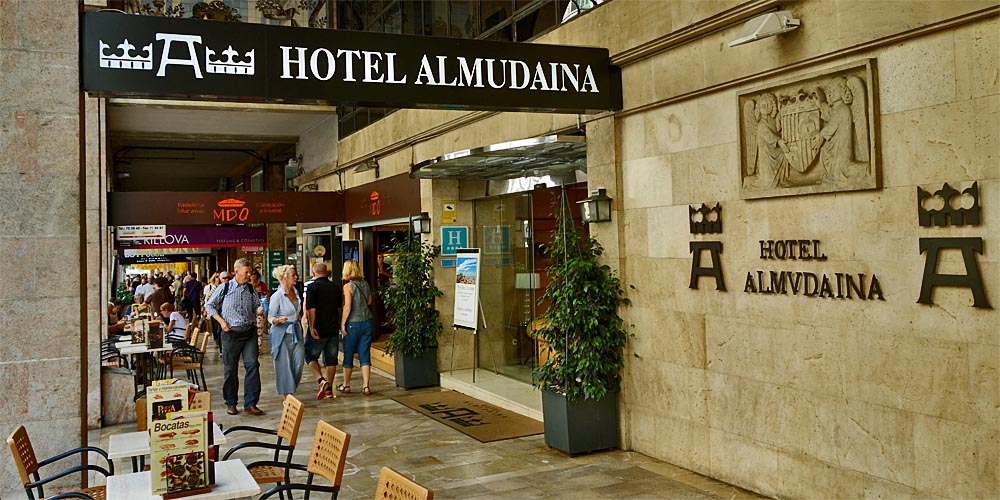 Underneath the hotel and next to its entry is a kind of
Bistro MDQ (no
idea what these letters stand for)
which is hugely popular.
Underneath the hotel and next to its entry is a kind of
Bistro MDQ (no
idea what these letters stand for)
which is hugely popular.
It serves pies, pastries,
ice cream, tapas, pizzas and other dishes as well as a
range
of drinks. I do spend much time there, observing the very
effective staff of 4-5 racing round, making jokes mongst themselves.
On my
second day there (making a few occasional comments)
they started to take special note of me with the odd free
glass of wine, double size cognacs, peanuts etc.
They serve Spanish cognac Terri here, with its
bottle (as I remember from 55 years ago) still in its
unique yellow knitted stocking. For me a real nostalgia
drink.
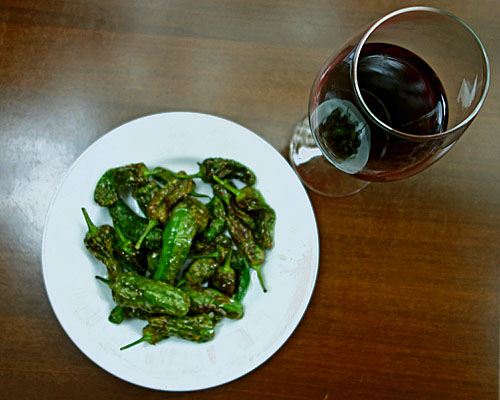 Another item which brings back fond memories is a popular
tapa : Pimientos de Padron (those shown here are
from Bistro Forn des Teatre), small, sweet peppers fried
in olive oil and sprinkled with course sea salt.
Another item which brings back fond memories is a popular
tapa : Pimientos de Padron (those shown here are
from Bistro Forn des Teatre), small, sweet peppers fried
in olive oil and sprinkled with course sea salt.
In the old days there usually lurked the odd really
hot pepper within the dish which always caused laughter
and knowing smiles from the locals when you struck one.
The formation of the EU has had its benefits but also its
negatives for Southern European countries, especially the
areas right around the Mediterranean sea.
The huge influx of North European tourists has boosted the
local economies, but at the same time destroyed much it
the original culture. Shoeshine boys and night-watchmen
(called cerenas, who could provide you with a room
at any hour of the night) are no more. The tourist shops
sell T-shirts, and espadrilles without strings, but no
longer the typical clay water bottles, glass perons or
botas (leather sheepskin wine sacs).
Comments -
Most Recent -
Next Page -
Previous -
Top -
Page 1 -
Photos -
Maps & Articles -
Jazclass
© 2014 Michael Furstner













 Another item which brings back fond memories is a popular
tapa : Pimientos de Padron (those shown here are
from Bistro Forn des Teatre), small, sweet peppers fried
in olive oil and sprinkled with course sea salt.
Another item which brings back fond memories is a popular
tapa : Pimientos de Padron (those shown here are
from Bistro Forn des Teatre), small, sweet peppers fried
in olive oil and sprinkled with course sea salt.